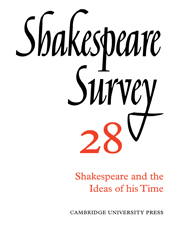Book contents
- Frontmatter
- ‘Richard II’ and the Realities of Power
- The Politics of Corruption in Shakespeare’s England
- Literature without Philosophy: ‘Antony and Cleopatra’
- Self-consciousness in Montaigne and Shakespeare
- ‘Measure for Measure’: The Bed-trick
- Shakespeare and the Doctrine of the Unity of Time
- ‘Coriolanus’ and the Body Politic
- ‘Titus Andronicus’, iii, i, 298–9
- ‘The Merchant of Venice’ and the Pattern of Romantic Comedy
- The Integrity of ‘Measure for Measure’
- ‘To Say One’: An Essay on ‘Hamlet’
- ‘The Tempest’ and King James’s ‘Daemonologie’
- Sight-lines in a Conjectural Reconstruction of an Elizabethan Playhouse
- The Smallest Season: The Royal Shakespeare Company at Stratford in 1974
- The Year's Contributions to Shakespearian Study 1 Critical Studies
- 2 Shakespeare’s Life, Times, and Stage
- 3 Textual Studies
- Index
- Plate section
‘Titus Andronicus’, iii, i, 298–9
Published online by Cambridge University Press: 28 March 2007
- Frontmatter
- ‘Richard II’ and the Realities of Power
- The Politics of Corruption in Shakespeare’s England
- Literature without Philosophy: ‘Antony and Cleopatra’
- Self-consciousness in Montaigne and Shakespeare
- ‘Measure for Measure’: The Bed-trick
- Shakespeare and the Doctrine of the Unity of Time
- ‘Coriolanus’ and the Body Politic
- ‘Titus Andronicus’, iii, i, 298–9
- ‘The Merchant of Venice’ and the Pattern of Romantic Comedy
- The Integrity of ‘Measure for Measure’
- ‘To Say One’: An Essay on ‘Hamlet’
- ‘The Tempest’ and King James’s ‘Daemonologie’
- Sight-lines in a Conjectural Reconstruction of an Elizabethan Playhouse
- The Smallest Season: The Royal Shakespeare Company at Stratford in 1974
- The Year's Contributions to Shakespearian Study 1 Critical Studies
- 2 Shakespeare’s Life, Times, and Stage
- 3 Textual Studies
- Index
- Plate section
Summary
And make proud Saturnine and his emperess
Beg at the gates, like Tarquin and his queen.
No editor so far seems to have investigated the source of the vehicle in this comparison. Yet Shakespeare, if it be he, as generally admitted, who wrote the scene, surely had in mind an incident in early Roman history as understood in his age. Now the obvious auctor for it would have been Livy and we shall begin with him. His first book, ad finem (1, 60.1–2), tells how Tarquin (Lucius Tarquinius Superbus), having heard, at his camp before Ardea, of the rising in Rome consequent upon Lucrece’s suicide, set out to quell it, but ‘Tarquinis clausae portae, exsiliumque indictum (the gates were closed to Tarquin and exile notified to him).’ The gates are here all right but no mention is made of the begging.
So let us try another historian, hardly less honoured and trusted by the men of the Renaissance, Dionysius of Halicarnassus. His history of early Rome had already been translated more than once from the original into a more widely accessible learned language, so that Shakespeare could read him with his 'small Latin' without resorting to his 'less Greek'.
- Type
- Chapter
- Information
- Shakespeare Survey , pp. 71 - 74Publisher: Cambridge University PressPrint publication year: 1975



